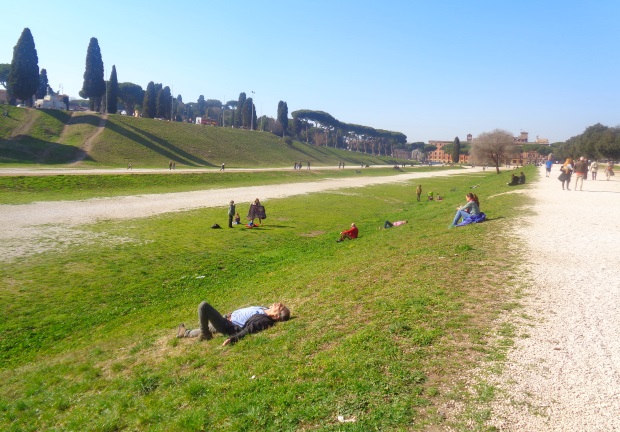The Circus Maximus was a stadium for chariot races and other games in ancient Rome. It is centrally located in the centre of Rome then and now. It was an oval arena with a gigantic length of 600 metres and a width of almost 150 metres. Around the Circus Maximus there were large grandstands, which in their greatest time offered space for about 250,000 spectators (in the 1st century A.D.).
Already in the 6th century before Christ competitions took place here. In the 1st century before Christ, at the time of Caesar, the Circus Maximus (Italian: Circo Massimo) was extended. Around the long racecourse places for spectators were created. A moat was built between the spectators and the track. It was supposed to protect the spectators. The 600 metre long circus was not only used for car races. Hunting games with wild animals were also held here, including tigers, lions, giraffes, elephants and other exotic animals. But also native animals like wild boars or deer had to be hunted frequently in the Circus Maximus. There were also long-distance races and other athletics in the ancient arena. The famous gladiator competitions were also held here, although not as frequently as in the nearby Colosseum. Races and games took place in the Circus Maximus for about 600 years, until about the 6th century AD.
Important for travellers to Rome: We have only seen queues of hundreds of metres or several hours in Europe in Rome. This is especially true for St. Peter’s Basilica, the Colosseum and the Vatican Museum. Tickets without queuing (skip-the-line tickets) must be bought in advance on the internet and go past the queue!: This link offers such tickets
But also native animals such as wild boars or deer often had to be hunted in the Circus Maximus. There were also, for example, long-distance races and other athletics in the ancient arena. The famous gladiatorial contests also took place here, although not as often as in the nearby Colosseum. Races and games were held in the Circus Maximus for around 600 years, until about the 6th century AD.
Youtube movie about the ancient Circus Maximus (english, 3 min)
The Circus Maximus Rome today
The Circus Maximus still exists today in full size. But most visitors are rather disappointed. Little of the former venue has been preserved.

You can still see the shape of the former gigantic arena. Where the spectator terraces used to be, there is now a hill to the left and right of the 600 meter long sides. The large square is now covered with grass to a large extent. An ideal place in warm Rome to lie in the sun or for a picnic.
From the former buildings and grandstands almost nothing is preserved. The Circus Maximus is an open space in the middle of the city of Rome. The Circus Maximus does not cost admission, there are no opening hours. Sometimes big events like concerts (rock etc.) with several 100.000 spectators take place here.
Approach Circus Maximus
Parking is not very easy in the centre of Rome, you go better with the subway (Metro).
Circus Maximus has a subway stop called “Circo Massimo” of line B. The Colosseum of Rome is only one stop away, the Central Station Termini 3 stations.Two tram lines also stop at one end of the former arena.Nearby is the Tiber River and the Tiber Island.
The Szechenyi Thermal Bath in Budapest, one of the most beautiful public baths in Europe.
Circus Maximus History
The Circus Maximus, one of the largest and most spectacular stadiums in ancient Rome, was located in the valley between the Aventine and the Palatine. The stadium was used for a variety of spectacles, including horse and chariot races, athletics, gladiatorial combat and animal hunts.
The exact date of construction of the Circus Maximus is not known, but it is thought to have been built in the 6th century BC. During the Republic, chariot races and other sporting events were held in the circus, and it was expanded and renovated several times over the centuries. In the 1st century AD, the Circus was rebuilt by Emperor Trajan and became one of the largest arenas in the ancient world, with a capacity of up to 250,000 spectators. Over the centuries, the Circus Maximus has been the scene of many memorable events, including the triumphal procession of Julius Caesar in 46 BC. A naval battle is re-enacted by rowing a ship in the centre of the stadium. The Circus Maximus was also the setting for his game Gladiator, in which slaves and prisoners fought to the death for the entertainment of the spectators.
The Circus Maximus was not only a venue for sporting events and spectacles, but also an important political and social centre of ancient Rome. Emperors used the stadiums to demonstrate their power and prestige, and politicians held elaborate games and competitions here to win popular support.
Despite its importance in ancient Rome, the Circus Maximus fell into disrepair after the fall of the Roman Empire. The stadium was used as a pasture for cattle and much of the stone was quarried for building materials. From the 19th to the 20th century, excavations at this site uncovered the remains of an ancient stadium. Today, visitors can still make out the outline of the Circus Maximus and imagine the splendour of ancient spectacles.
Despite its long history and cultural significance, the Circus Maximus remains an impressive and awe-inspiring monument to ancient Rome. A testament to the unbroken spirit of the Roman people and the greatness of their civilisation, it is an essential destination for visitors to the city who wish to experience the history and culture of ancient Rome.